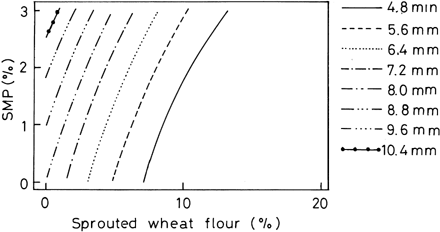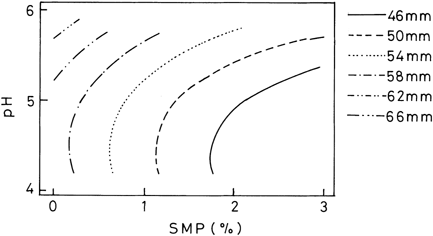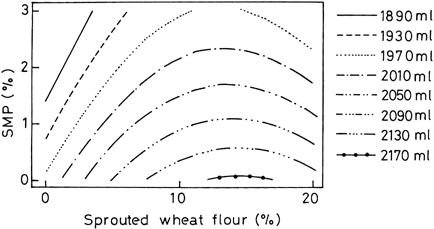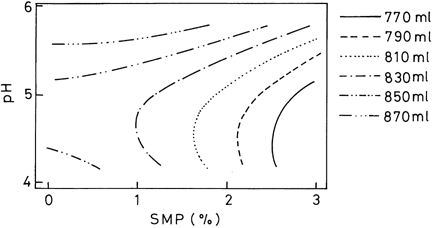ABSTRACT
Studies were undertaken to see the effect of addition of sprouted wheat flour (0, 10, and 20%), skim milk powder (0, 1.5 and 3.0%) and change of dough pH (5.8, 5.0 and 4.2) with diluted HCl on rheological, gas release and bread making properties of flour. The regression to fit a response surface analysis was used to describe dough characteristics measured using Brabender Farinograph and Chopin Rheofermentometer F2. Bread volume was also measured and described. Sprouted wheat flour showed the most pronounced effect on water absorption, dough stability and CO2 production whereas skim milk powder (SMP) showed highly significant effect on dough height (Hm), CO2 production and bread volume. Addition of sprouted wheat flour upto 10% level improved dough development and gaseous release properties of flour without having any significant adverse effect on bread volume. SMP improved dough stability and diminished water absorption, dough development and gaseous release properties of flour. Inclusion of all the three variables together in the bread formula showed adverse effect on dough properties and bread volume. All models computed correlate well with the measured data and were statistically significant (p≤0.005). R 2 values of majority of models were greater than 90%.
INTRODUCTION
Different optional ingredients such as hydrocolloids, skim milk powder (SMP), fat, acids, bran and gluten are included in bread formulation to improve its nutritional, shelf life and organoleptic properties Citation1-6. The pH of dough is lowered using different acids in order to improve the shelf life of the resultant bread. Treatment of flour with acetic acid has been suggested as an alternate to bromate and ascorbic acid in bread making Citation[7]. Bennett and Ewart Citation[8] reported that acids react strongly with the protein of dough.They reported a marked reduction in dough extensibility as a result of acid addition and attributed the effect to the addition of hydrogen ion to the dough Galal et al. Citation[9] described that lowering the pH resulted in an increase in net positive charge on the proteins. A combination of lowering the pH, increasing the salt concentration and adding L-cysteine HCl was observed to be effective in producing acceptable quality bread from high maltose value flours Citation[10]. Sekhon et al. Citation[11] described the beneficial effect of lowering pH and addition of vital gluten in the production of bread from highly sprouted wheat flour. Milk solids are included in bread formulation to improve the nutritional and keeping quality of bread. The inclusion of milk solids produces bread with open grain and harder texture Citation[12].
Rain at harvest has been a common phenomenon in the Indian subcontinent which lead to sprouting of grains and brings about increase in the enzymatic activity along with several other chemical changes in the grain Citation[11], Citation[13]. Flour milled from sprouted wheat can be used for certain baked products, but it poses a challenge to the bread manufacturers. Bread manufacturers blend sprouted flour and decrease pH in order to enhance the shelf life of bread.
In the present study we have reported the effect of addition of sprouted wheat flour, SMP and a change in dough pH with diluted HCl on dough development, gas formation and retention and bread making properties of flour using regression analysis.
MATERIALS AND METHODS
Preparation of Samples and Milling
Wheat cultivar HD-2329 was procured from 1997 harvest and sprouted at 25°C for 48 h after soaking in water for 8 h as described earlier Citation[13]. Sound and sprouted wheat samples were conditioned before milling to 13% moisture by adding calculated quantities of water. The samples were kept in air tight container for 24 h prior to milling. The conditioned wheat was then milled on Brabender Quadrumatic Junior Experimental Mill.
pH of Dough
The pH of the dough was adjusted to 5.8, 5.0 and 4.2 as described earlier Citation[14].
Analysis
Moisture, protein, ash, gluten and Falling Number were determined according to AACC methods Citation[15].
Materials
SMP was procured from local market. Bakers compressed yeast (Tower brand, Calcutta) was used.
Farinographic Properties
Constant flour method of AACC was followed to study the effect of SMP, sprouted wheat flour and pH on farinographic properties.
Dough Development and Gaseous Release Characteristics
The Rheofermentometer (Chopin, Tripette & Renaud, France) as described earlier Citation[16] was used to study the effect of different ingredients on dough development and gas formation properties of flours. Weighed quantities of compressed yeast (7 g) and salt (5 g) were dissolved in small quantity of distilled water separately. Flour (250 g), water (optimum), yeast and optional additives were mixed optimally in laboratory mixer (National Manufacturing Company, Lincoln, NE) using water absorption and dough development time determined using a farinograph. The salt solution was added to the dough during the last minute of mixing. The kneading was finished at 30°C into a smooth dough by stretching and folding manually. A portion of the dough (350 g) was placed in the removable basket of the gasometer and a resistance weight (762 g, equivalent to 7.62 g/cm2) was placed directly on the dough. The cover of the vat was fitted with an optical sensor and the test was run for 3 h at 29.5°C. Maximum dough height (Hm), maximum height of gaseous release (Hm′) and CO2 production were measured.
Bread Making
Wheat flour (220 g), compressed yeast (5 g), sugar (4 g), salt (3 g) and water absorption according to farinograph absorption at 500 BU were used. All the ingredients were mixed to optimum development in a mixing bowl with a laboratory mixer (National Manufacturing Company, Lincoln, NE). The kneading was finished at 30°C into smooth dough by stretching and folding manually and fermented for 75 min in a fermentation cabinet (National Manufacturing Company, Lincoln, NE) maintained at 30°C and 85% RH. The dough was remixed for 30 sec in the same mixer and moulded on a National moulder after which it was proofed for 60 min and then baked at 235°C for 25 min in a reel type oven (National Manufacturing Company, Lincoln, NE). The volume of breads prepared in triplicate was measured by rapeseed displacement method.
Statistical Analysis
The second order polynomials were computed using three variables at three levels experimental design by regression using Minitab Statistical Software (Minitab Inc. USA). SMP, sprouted wheat flour and pH were using as independent variables. These variables had values of X 1 (SMP), 0, 1.5, 3.0; X 2 (sprouted wheat flour) 0,10, 20 and X 3 (pH), 5.8, 5.0, 4.2. The polynomials were fitted to measure the dependent variables such as water absorption, dough stability, dough development time, degree of softening, Hm, Hm′ and bread volume. The polynomial equation fitted to the dependent variables (y i) was:
RESULTS AND DISCUSSION
Sound wheat flour used in the present study has protein, ash, wet gluten and falling number values of 9.6%, 0.45%, 29% and 350 s, respectively, while sprouted wheat has 9.65%, 0.55%, 27% and 72 sec, respectively. The second order polynomials were computed for water absorption, dough stability and dough development time measured using farinograph; Hm, Hm′ and CO2 production measured using Rheofennentometer and bread volume using actual variables. The experimental results and regression models tabulated are reported in Table and , respectively. Majority of the models correlate well with the measured data and are statistically significant. R 2 values for all the models except of Hm′ was above 90% which represents the proportion of variability of data accounted for the model Citation[17]. The standard error of estimates also are shown in Table .
Table 1. Experimental Design and Results
Table 2. Coefficient and Significance of Regression Model
Farinographic Properties
Addition of sprouted wheat flour showed the highly significant effect both in linear and squared terms on the dough stability of flour (p<0.005). Figure illustrates the effect of addition of sprouted wheat flour and SMP on dough stability at pH 5.0. The sprouted wheat flour interacted significantly with SMP and pH in affecting the dough stability. SMP also showed significant effect both in linear and squared terms, however at higher value (p≤0.5). The pH showed significant effect in squared terms at p value of <0.005. Dough stability progressively decreased with the increase in sprouted wheat flour and pH and increased with the increase in SMP. The reduction in pH from 5.8 to 4.2 with and without addition of SMP at different levels resulted into a significant deterioration in dough stability. The reduction in dough stability caused by addition of sprouted wheat flour may be attributed to softening of gluten proteins Citation[13]. Whereas improvement with the addition of skim milk may be attributed to the presence of high levels of calcium in it. The salt has been reported to increase mixing time and dough stability Citation[18]. Srivastava and Haridas Rao Citation[4] also observed similar effect of SMP on farinographic characteristics of flour. The regression analysis also revealed a significant effect of sprouted wheat flour, SMP and pH on water absorption and dough development time of flour. Farinograph water absorption decreased with the increase in sprouted wheat flour, SMP and pH. Among three variables studied, sprouted wheat flour showed the greatest effect on water absorption and dough development time followed by pH and SMP. Similar effects of germinated wheat flour and SMP on water absorption have been reported earlier Citation[4], Citation[18]. Dough development time decreased with the increase in sprouted wheat flour and decrease in pH. The addition of SMP improved the dough development time. Sprouted wheat flour and pH showed significant effect on dough development time both in linear and squared terms while SMP showed significant effect in linear terms only.
Rheofermentometer Properties
The statistical analysis of Rheofermentometer data in Table obtained using response surface regression analysis showed significant effect of SMP and pH on Hm value both in linear and squared terms p<0.005). The addition of sprouted wheat flour also showed significant effect on Hm, however, in squared terms only. The sprouted wheat flour and pH interacted significantly in affecting Hm value. The Hm value decreased with the increase in SMP and decrease in pH from 5.8 to 5.0 (Fig ). The addition of sprouted wheat flour resulted in an increase in Hm value. The changes in dough characteristics with the addition of sprouted wheat flour may be attributed to increase in amylolytic and proteolytic activity Citation[13], Citation[18] while those by reduction in pH to the reduction in –SH groups Citation[19]. Hm′ increased with the addition of sprouted wheat flour and decreased with the SMP. Sprouted wheat flour and SMP showed significant effect on Hm′ both in linear and squared terms, however, at higher p value (p≤0.5). Sprouted wheat flour, SMP and pH showed significant effect on the total CO2production during fermentation. The addition of sprouted wheat flour showed the most pronounced effect on total CO2 production followed by SMP and pH (Fig. ). The pH interacted significantly with SMP and sprouted wheat flour in affecting the total volume of CO2 production. Total volume of CO2 production decreased with the increase in SMP and increased with the increase in sprouted wheat flour. The increase in CO2 production with the increase sprouted wheat flour may be attributed to an increase in diastatic activity of flour. CO2 production decreased with the decrease in pH to 4.2 which may be attributed to inhibition of yeast fermentation Citation20-21. The addition of acids results into denaturation of protein and inhibition of metabolic enzymes Citation[22].
Bread Volume
The statistical analysis in Table showed that SMP and pH had the most pronounced effect on bread volume followed by sprouted wheat flour. SMP and pH showed significant effect both in linear and squared terms. While, the effect of sprouted wheat flour was significant in squared terms only. Figure shows the effect of SMP and pH on bread volume. Bread volume progressively decreased with the increase in SMP and sprouted wheat as well as decrease in pH. The sprouted wheat flour and SMP interaction effect on bread volume was highly significant. Dubois and Tatrick Citation[23] also reported similar reduction in bread volume with the addition of SMP.
CONCLUSION
In summary, addition of sprouted wheat flour upto 10% level improved dough development and gaseous release properties of flour without having any significant adverse effect on bread volume. SMP improved dough stability and diminished water absorption, dough development and gaseous release properties of flour. Inclusion of all the three variables together in the bread formula showed more adverse effect on dough properties and bread volume. Majority of models correlate well with the measured data and were statistically significant at the p<0.005 level. R 2 values of all the models except Hm' were greater than 90%. The models computed can be used as a tool to predict and manipulate dough and bread characteristics.
Acknowledgments
REFERENCES
- Sultan , W.J. 1980 . “ Shortening and their Uses ” . In Practical Baking , 3rd Ed. 5 – 10 . West Port, CT : AVI Publishing .
- Chung , O.K. and Pomeranz , Y. 1983 . Recent Trends in Usage of Fats and Oils as Functional Ingredients in the Baking Industry . Journal of American Oil Chemist's Society , 60 : 1847 – 1851 .
- Singh , N. , Kaur , H. , Sekhon , K.S. and Kaur , B. 1991 . Studies on the Improvement of Functional and Bread Making Properties of Wheat-Chickpea Flour Blends . Journal of Food Processing and Preservation , 15 : 391 – 402 .
- Srivastava , A.K. and Haridas Rao , P. 1991 . Effects of Using Different Sources of Milk Products on the Quality of Bread . Journal of Food Science and Technology , 30 : 109 – 113 .
- Mettler , E. and Seibel , W. 1993 . Effects of Emulsifiers and Hydrocolloids on Whole Wheat Bread Quality: A Response Surface Methodology Study . Cereal Chemistry , 70 : 373 – 376 .
- Sekhon , K.S. , Dhillon , S.S. , Singh , N. and Singh , B. 1997 . Suitability of Commercial Milled Rice Bran in India for Use in Different Food Products . Plant Foods for Human Nutrition , 50 : 127 – 140 .
- Seguchi , M. , Hayashi , M. and Matsumoto , H. 1997 . Effect of Gaseous Acetic Acid on Dough Rheological and Breadmaking Properties . Cereal Chemistry , 74 : 129 – 134 .
- Bennett , R. and Ewart , J.A.D. 1962 . The Reaction of Acids with Dough Protein . Journal of the Science of Food and Agriculture , 13 : 15 – 23 .
- Galal , A.M. , Varriano-Marston , E. and Johnson , J.A. 1978 . Rheological Dough Properties as Affected by Organic Acids and Salt . Cereal Chemistry , 55 : 683 – 691 .
- Ranhotra , G.S. , Loewe , R.J and Lehmann , T.A. 1977 . Breadmaking Quality and Nutritive Value of Sprouted Wheat . Journal of Food Science , 42 : 1373 – 1375 .
- Sekhon , K.S. , Singh , N. , Kaur , H. and Nagi , H.P.S. 1995 . Improving the Functional and Bread Making Properties of Sprouted Wheat . Journal of Food Processing and Preservation , 19 : 147 – 164 .
- Marston , P.E. 1971 . The Use of Dairy Products in Bread and Other Baked Goods . Food Technology in Australia , 23 : 506 – 509 .
- Singh , N. , Sekhon , K.S. and Nagi , H.P.S. 1987 . Laboratory Sprout Damage and Heat Treatment on Milling and Baking Properties of Indian Wheats . Journal of Food Science , 52 : 176 – 179 .
- Singh , H. , Singh , N. and Kaur , K. 1999 . Effects of Additives and pH on Dough Development and Gas Release Characteristics of Sound and Sprouted Wheat . Journal of Food Science and Technology , 35 : 393 – 398 .
- AACC. 1990. Approved Methods of American Association of Cereal Chemist's. 8th ed. The Association, St. Paul, MN.
- Czuchajowska , Z. and Pomeranz , Y. 1993 . Gas Formation and Gas Retention. I.The System and Methodology . Cereal Foods World , 38 : 499 – 503 .
- Gardiner , W.P. 1997 . Statistical Analysis Methods for Chemists. A Software-Based Approach 168 – 226 . Cambridge : The Royal Society of Chemistry .
- Sekhon , K.S. , Singh and Nagi , H.P.S. 1992 . Effect of Pearling and Blending on the Bread-Making Properties of Sprout-Damaged Wheat . Cereal Foods World , 37 : 715 – 716 . 721–724
- Tsen , C.C. 1966 . A Note on Effect of pH on Sulfhydryl Groups and Rheological Properties of Dough and Its Implication with the Sulihydryl-Disulfide Interchange . Cereal Chemistry , 43 : 456 – 460 .
- Gujral , H.S. and Singh , N. 1999 . Effect of Additives on Dough Development, Gaseous Release and Bread Making Properties . Food Research International , 32 : 691 – 697 .
- Kaur , K. and Singh , N. 1999 . Effect of Acetic Acid and CMC on Rheological and Baking Properties of Flour . Journal of Food Quality , 22 : 317 – 327 .
- Yamamoto , Y. , Hiraiwa , T. , Higashi , K. and Yoshii , H. 1989 . Protective Effect of Liver Extract on Acetic Acid Inhibition Against Debaryomyces Hansenii . Nippon Shokuhin Kogyo Gakkaishi , 36 : 1 – 6 .
- Dubois and Tatrick . 1984 . “ Functionality of Non-fat Dry Milk in Bakery Products ” . In Dairy Products for the Cereal Processing Industry , Vetter Ed. Edited by: James , L. 91 – 124 . Minnesota : The American Association of Cereal Chemists Inc .



